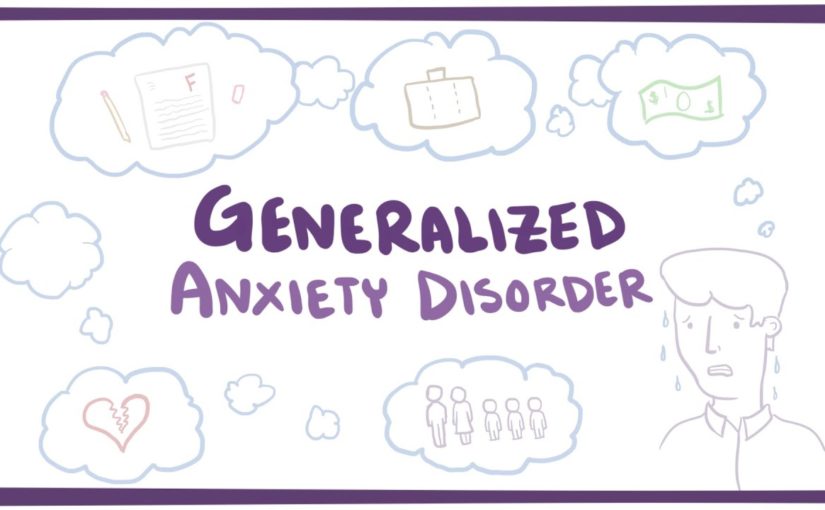
Generalized anxiety disorder (GAD) – causes, symptoms & treatment
Say you’ve got a huge presentation in front
of all your colleagues; you’re nervous, you’ve got quite a bit of stress leading
up to the presentation. That stress is completely normal, and really—probably
useful in certain situations since it can make you more alert and careful. After the presentation’s over you feel the
stress start to fade away, right? Well…for 3% of the population, the stress
doesn’t go away, and maybe that stress isn’t even brought on by a specific event and is
always just sort of always there. Either way, at this point it’s considered
to be anxiety. That anxiety might even get worse over time
and causes things like chest pains or nightmares. Sometimes the anxiety’s so severe that it
causes someone to be anxious about leaving the house or doing everyday things, like going
to work or school. This anxiety may be a sign of Generalized
Anxiety Disorder, sometimes shortened to GAD.
GAD’s characterized by excessive, persistent,
and unreasonable anxiety about everyday things, like money, family, work, and relationships;
even sometimes the thought of getting through the day causes anxiety. If the anxiety’s persistent, then it doesn’t
seem to go away, if it’s excessive, it’s usually more than someone else might feel,
and if it’s unreasonable, they probably shouldn’t have a reason to feel anxious
about it. People who have GAD might even understand
that their anxieties are excessive and unreasonable, but they feel it’s out of their control
and doesn’t quite know how to stop it. People with severe GAD might be completely
debilitated and have trouble with the simplest daily activities, or they might be only mildly
affected and be able to function socially and hold down a job. Sometimes the feelings might worsen or improve
over time. In addition to having feelings of worries
and anxiety, other symptoms include edginess and restlessness, difficulty concentrating
or feeling like the mind just goes blank, and also irritability.
These psychological symptoms can also lead
to physical manifestations of symptoms like digestive problems from eating more or eating
less. They might also have muscle aches and soreness
from carrying tension in their muscles. Finally, difficulty sleeping is a really common
symptom that can have a serious impact on physical well-being, since the body’s not
resting and can lead to issues of chronic fatigue. Although the decision that someone’s worry
is excessive and unreasonable has a subjective quality, diagnosing GAD is aided by the diagnostic
and statistical manual of mental disorders, or DSM-V, this manual gives a list of criteria
to meet in order to be diagnosed with GAD. First, the excessive worry and anxiety have
to have been present for more days than not over the course of 6 months. In other words, a person should have the symptoms
of excess or unreasonable worry on 90 or more days out of 180 days.
Generally, people can’t quantify or track
their feelings in that way, so again, this is meant to offer a general guideline, right? Okay second—the person finds it hard to
control their anxiety, meaning that they have a hard time calming themselves or “self-soothing”
to help themselves regain control over their feelings. Third, an adult must have three or more of
the symptoms listed previously. In children though, typically defined as “school-age”,
so between 6 and 18 years old, only one symptom is needed for the diagnosis of GAD. Another criterion is that anxiety causes
impairment in important daily activities like school or work. For example, they might miss deadlines or
find it difficult to even go to work because of their symptoms. Fifth, the symptoms are not attributable to
the physiologic effects of drugs or medication, or due to a medical condition like hyperthyroidism
which creates an excess of thyroid hormone, which can sometimes cause symptoms of anxiety
and worry.
Finally, their anxiety isn’t better explained
by another mental disorder like social phobia or panic disorder. Just like a lot of mental disorders, it’s
unclear exactly why some individuals develop a generalized anxiety disorder, but it’s thought
to be a combination of genetic and environmental factors, as it seems to run in families. It also has been shown to be twice as prevalent
in females as in males. Treating GAD, like many mental disorders,
may involve psychotherapy, medication, or a combination of the two. If it’s psychotherapy, cognitive behavior
therapy has been effective since it teaches the patient to think and behave in different
ways and react differently to situations that would usually cause anxiety and worry. Medications like benzodiazepines or antidepressants
might be prescribed as well, benzodiazepines are a type of psychoactive drug that has
a relaxing and calming effect.
Antidepressants might also be prescribed,
like selective serotonin reuptake inhibitors, or SSRIs, which regulate the serotonin levels
in the brain and help elevate mood. Even though both medications and cognitive
behavior therapy have similar effectiveness in the short-term, cognitive behavior therapy
has major advantages over medication in the long term, due to unwanted effects of the
medications like tolerance, dependence, and withdrawal…



